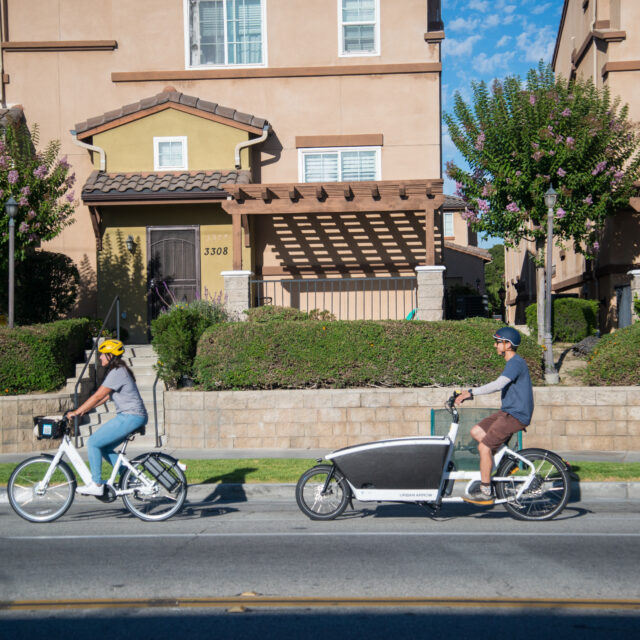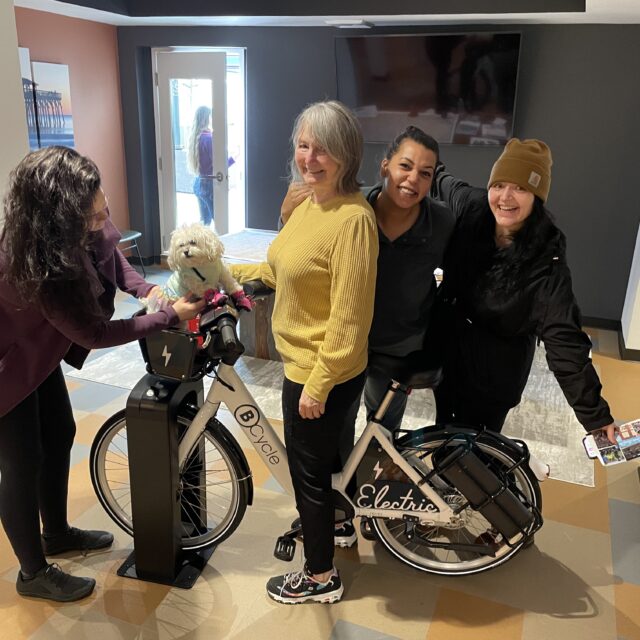Santa Cruz is Getting a Regional Bike Share System
by Kiran Herbert, Communications Manager
July 25, 2023
In late June, 400 bikes were deployed in Santa Cruz and on the University of California, Santa Cruz campus. Eventually, the system will grow to include most of the county.

Photo credit: Bill Bishoff
Santa Cruz County, located just south of San Francisco and San Jose, on stunning Monterey Bay, has a population of just over 262,000 people. It includes the county seat and largest city, Santa Cruz, along with Capitola, Watsonville, and Scotts Valley, with unincorporated areas in between. The region boasts temperate temperatures year-round and a lot of intercounty travel, making it the ideal location for a new, regional bike share system.
The new system, owned and operated by BCycle, launched on June 20 with 400 electric bikes throughout the City of Santa Cruz and the University of California, Santa Cruz (UCSC) campus. The countywide rollout — which is tentatively set for early next year — will eventually extend the system to include 660 total e-bikes and 1,320 total docks in the cities of Capitola and Watsonville, unincorporated parts of the county, and the Cabrillo College campus.
Bike share isn’t new to the region: From 2018 to 2020, the City of Santa Cruz was home to a dockless system run by now-defunct Jump, an Uber subsidiary that was eventually sold to Lime. Jump did well in Santa Cruz, with each bike averaging 4.9 trips per day and each trip averaging a distance of 1.9 miles — numbers that speak to a healthy and flourishing bike share system. When Lime took over Jump, however, it began to reassess all of its markets. Santa Cruz was presented with the choice of either adding e-scooters into the mix or losing its system completely.
Due to several rogue e-scooter drops by various micromobility companies, the addition of e-scooters made the proposal a non-starter. According to Claire Gallogy — a longtime Transportation Planner for the City of Santa Cruz — the general community and elected officials preferred then, as they do now, a bike-only system. Soon after the Jump disbanded, Gallogy began the process of envisioning what a new (and improved) system would look like.
“In mid-2020, discussions began with six jurisdictions and collectively, we decided to move forward with a regional system,” says Gallogy, adding that an official Request for Information (RFI) was released in April 2021, and the Request for Proposals (RFP) shortly thereafter in October 2021. “It would have been much faster to do a standalone system for the city [of Santa Cruz] but it won’t have the broad impact our regional system will eventually have.”
There are currently few regional bike share systems in the country. ValleyBike Share, which was designed to service the Massachusetts communities of Amherst, Northampton, South Hadley, Holyoke, and Springfield, has been in limbo since its operator Bewegen declared bankruptcy. In California’s San Gabriel Valley, the nonprofit ActiveSGV runs GoSGV, which serves the entire region but utilizes a monthly subscription model. Shift Bike, which operates in Eagle County, Colorado, and WeCycle in Colorado’s Roaring Fork Valley, offer two other regional models geared towards the mountains. In Colorado’s Front Range, there’s talk of expanding the Boulder BCycle program to connect the jurisdictions of Broomfield, Boulder County, Erie, Lafayette, Longmont, Louisville, Superior, and Westminster.
When rethinking bike share in the context of Santa Cruz County, the six participating jurisdictions were open to a docked or dockless model, although there were a few things that were non-negotiable. First, all of the jurisdictions wanted to have a single operator, not only to build a deep partnership long-term but also to maintain some leveraging power when it came to negotiations. It was also critical that the operator be able to offer a monthly and annual rate so that the system could remain affordable for regular users. Lastly, it was important to everyone that Watsonville be included in the regional program.
“Watsonville is about the same size as the city of Santa Cruz, but it’s located in the southernmost end of our county — it has the lowest incomes in our county and many areas there qualify as disadvantaged communities under various state and federal definitions,” says Gallogy. “That doesn’t mean that they should be left out of bike share.”
A place like Watsonville, which borders some rural farmland, isn’t exactly an ideal market for many operators and several potential vendors noted that they would only sign on if Watsonville got nixed from the system. The six jurisdictions stood strong by their shared values and ultimately chose BCycle because the company bought into the vision. Says Gallogy, “Being a regional system meant that we could get a better system for everyone.”
While there is currently no formal low-income program, Gallogy hasn’t ruled out the possibility of an equity program. She’s quick to point out that a monthly bike share membership with unlimited 30-minute rides costs just $30, more than half the price of a parking permit or a transit pass (and annual membership costs $150). In the works is a program to make bike share free to downtown employees as part of the Go Santa Cruz Program, and through a special agreement with UCSC, students need only pay $12 a year ($50 for staff and other affiliates). In order to engage riders around the new system, the participating jurisdictions will also be doing a minimum of six safety and outreach events per year in partnership with BCycle.
The gradual rollout of the regional system was an intentional choice, a way for BCycle to ensure it had everything — from warehouse to staffing to the bicycle supply chain — in place for the optimal user experience. The company has signed a five-year contract with the City of Santa Cruz, Santa Cruz County, UCSC, Cabrillo College, Watsonville, and Capitola, with a “me-too clause” that would allow other jurisdictions to join down the road. Unique to the arrangement is the fact that, while there’s no public funding involved, there is the potential for eventual revenue-sharing: Starting in the third year of its contract, if BCycle makes a profit of more than 10% in the previous year, the company will pay the jurisdictions across the system $25 per dock.
Since its launch on June 20, a total of 10,578 rides have been taken, with the system averaging more than 500 trips a day. That puts the average trip per bike at three, an undeniable win.
“I’m looking forward to seeing how the program grows as we expand and build upon the success that we’re already having,” says Gallogy. “I think the experiment of going regional is going to be really fun to work on, and while I know there’ll be hiccups, I have a lot of faith in our team to work through them.”
The Better Bike Share Partnership is funded by The JPB Foundation as a collaboration between the City of Philadelphia, the National Association of City Transportation Officials (NACTO), and the PeopleForBikes Foundation to build equitable and replicable bike share systems. Follow us on LinkedIn, Facebook, Twitter, and Instagram, or sign up for our weekly newsletter. Have a question or a story idea? Email kiran@peopleforbikes.org.



